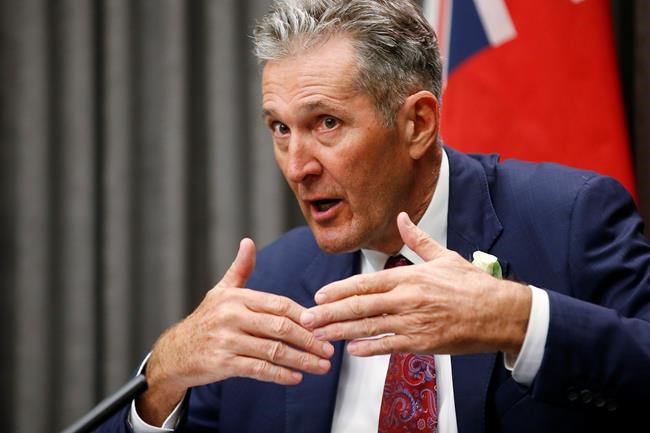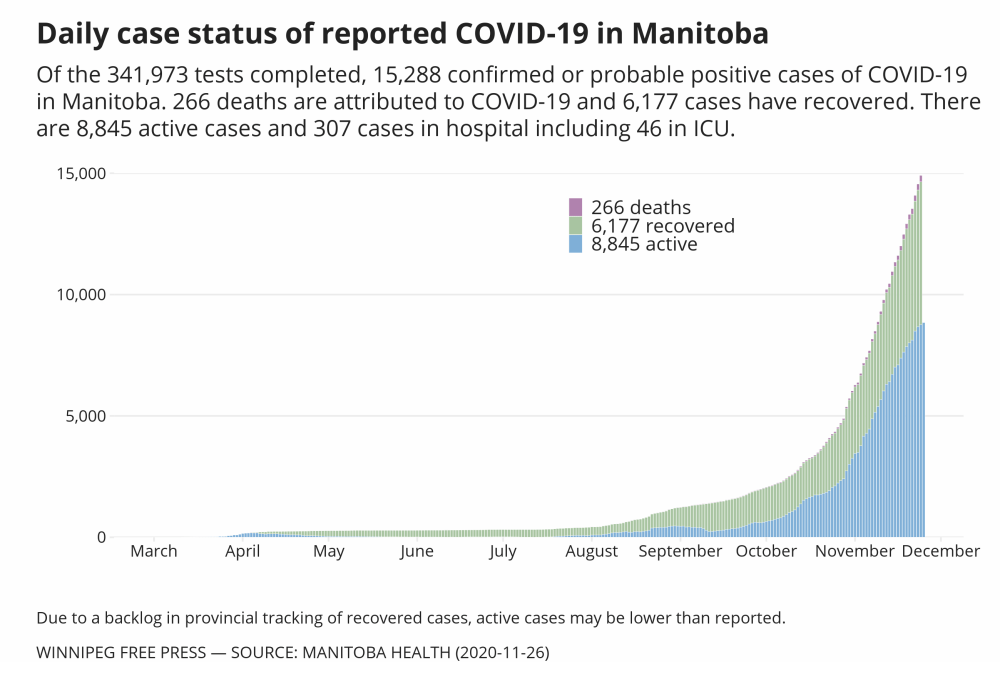That was then, the crisis is now Repeatedly telling Manitobans 'we know what to do' to gain control of runaway COVID-19 train simply isn't true
Read this article for free:
or
Already have an account? Log in here »
To continue reading, please subscribe:
Monthly Digital Subscription
$0 for the first 4 weeks*
- Enjoy unlimited reading on winnipegfreepress.com
- Read the E-Edition, our digital replica newspaper
- Access News Break, our award-winning app
- Play interactive puzzles
*No charge for 4 weeks then price increases to the regular rate of $19.00 plus GST every four weeks. Offer available to new and qualified returning subscribers only. Cancel any time.
Monthly Digital Subscription
$4.75/week*
- Enjoy unlimited reading on winnipegfreepress.com
- Read the E-Edition, our digital replica newspaper
- Access News Break, our award-winning app
- Play interactive puzzles
*Billed as $19 plus GST every four weeks. Cancel any time.
To continue reading, please subscribe:
Add Free Press access to your Brandon Sun subscription for only an additional
$1 for the first 4 weeks*
*Your next subscription payment will increase by $1.00 and you will be charged $16.99 plus GST for four weeks. After four weeks, your payment will increase to $23.99 plus GST every four weeks.
Read unlimited articles for free today:
or
Already have an account? Log in here »
Hey there, time traveller!
This article was published 26/11/2020 (1845 days ago), so information in it may no longer be current.
We hear it almost daily from Premier Brian Pallister and the province’s top doctor: Manitobans bent the COVID-19 curve in the spring and they know how to do it again.
I’m all for pandemic pep talks. But Manitobans now face an entirely different fight than we did in the spring. Whatever we did to bend the curve earlier this year isn’t going to work now.
“When we were abiding by the fundamentals, we were beating COVID,” Pallister said this week, a slogan he repeats ad nauseam. “Some of us lost our way and now COVID’s beating us.”

Chief provincial public health officer Dr. Brent Roussin says Manitobans know exactly what to do to bring case numbers down because we did it during the first wave of the pandemic.
“We’ve done it before and we’ll step up now and do it again,” he said.
That’s not entirely true. Manitobans didn’t have to contend with the massive caseloads and community transmission we now face. The complexities of fighting the pandemic today are entirely different than in the spring.
When Manitoba declared a provincewide state of emergency on March 20, there were only 17 reported cases of COVID-19. Schools, child-care centres, gyms and casinos were closed, bars and restaurants could only operate at 50 per cent capacity and gatherings were limited to 50 people.
Hand-washing and social distancing were still the main recommendations. Mask use among the general public was not encouraged.
Cases continued to climb in early April, forcing government to close bars, restaurants and non-essential businesses. Travel restrictions were imposed. Gathering limits fell to 10.
But two weeks after a state of emergency was called, there were still only 182 reported cases in the province. Most were travel-related. There was little, if any, community transmission.
Daily case numbers quickly fell to single digits by mid-April. Manitobans bent the curve and Pallister announced reopening plans April 29.
The virus had little chance to circulate widely in the spring. It was contained relatively quickly. It stayed that way for about two months. There were fewer than 10 new cases a week reported in May and June. There were no new cases in the first week of July.
Most Manitobans followed public-health orders. But those orders weren’t as strict. People could socialize in small circles, go to a bar and see a band, get a haircut or shop in-person for anything.
They can’t do that now.
There were plenty of sacrifices made in the first wave: people lost their jobs, some businesses went bankrupt and seven deaths were reported by early July.
But it was far easier to bring case numbers down (and keep them that way) in the spring and early summer, when the test-positivity rate was a fraction of one per cent.
Roussin predicted on Nov. 13, the day after the province went to code red, that under the new measures, case numbers would fall.
That modelling was wrong. Almost two weeks later, the five-day test positivity rate increased to a peak of 14.8 per cent Thursday, up from 11 per cent on Nov. 12. There are now more than 300 COVID-19 patients in hospital, a number that’s growing every week.
“It’s not like we don’t know what to do, or have trouble trying to figure out things — we know exactly what we can do,” Roussin said. “Our modelling shows that relatively quickly we’ll be back into manageable numbers.”
That modelling was wrong. Almost two weeks later, the five-day test positivity rate increased to a peak of 14.8 per cent Thursday, up from 11 per cent on Nov. 12. There are now more than 300 COVID-19 patients in hospital, a number that’s growing every week. Health officials have started organizing the third phase of its hospital expansion plan for off-site, low-acuity patients.
With the exception of schools and child-care centres (which remain open), the measures in place now are far more restrictive than in the spring. For the most part, people are following those orders. Pallister said “98 per cent” of people are abiding by the rules (though he has no data to support that). Meanwhile, the infection rate continues to climb.
Simply “following the fundamentals,” as Manitobans did in the spring, isn’t going to fix this. Repeating the mantra like a broken record that “we’ve done this before and we can do it again” is misleading and gives people false hope.
If Manitobans knew what to do to bring these numbers down, we would have done so by now.
tom.brodbeck@freepress.mb.ca

Tom has been covering Manitoba politics since the early 1990s and joined the Winnipeg Free Press news team in 2019.
Our newsroom depends on a growing audience of readers to power our journalism. If you are not a paid reader, please consider becoming a subscriber.
Our newsroom depends on its audience of readers to power our journalism. Thank you for your support.







